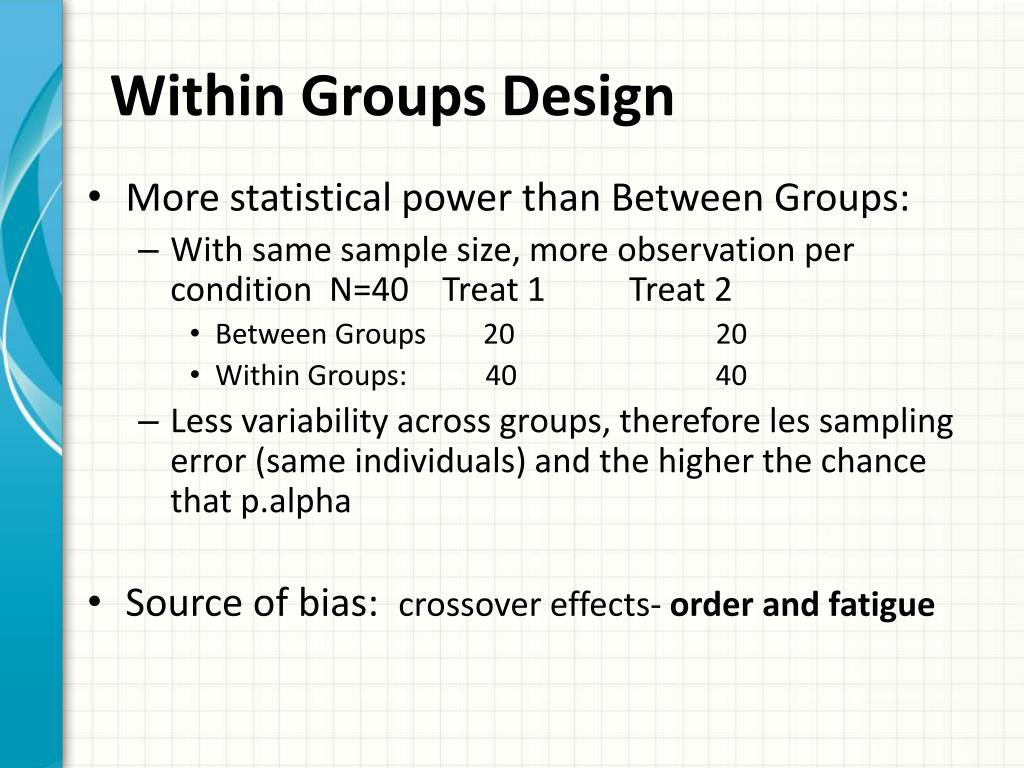Table Of Content

The most commonly used type is the single blind, which keeps the subjects blind without identifying them as members of the treatment group or the control group. In a single-blind experiment, a placebo is usually offered to the control group members. Occasionally, the double blind, a more secure way to avoid bias from both the subjects and the testers, is implemented. In this case, both the subjects and the testers are unaware of which group subjects belong to. The double blind design can protect the experiment from the observer-expectancy effect.
Within-Subjects Design Minimize the Noise in Your Data
Thus, random assignment plays an important role in within-subjects designs just as in between-subjects designs. Here, instead of randomly assigning to conditions, they are randomly assigned to different orders of conditions. In fact, it can safely be said that if a study does not involve random assignment in one form or another, it is not an experiment. Between subjects design, also known as an independent groups design, is a research method commonly used in experimental and quasi-experimental research. In this design, participants are randomly assigned to different groups, each of which is exposed to a different level or condition of the independent variable.
What is a 2×2 within subject design?
When the study is within-subjects, you will have to use randomization of your stimuli to make sure that there are no order effects. The principle of random allocation is to avoid bias in how the experiment is carried out and limit the effects of participant variables. A confounding variable could be an extraneous variable that has not been controlled. To compare the effectiveness of two different types of therapy for depression, depressed patients were assigned to receive either cognitive therapy or behavior therapy for a 12-week period. A pre- and post test involves measuring the groups of the study before the treatment and after the treatment. The desire normally is for the groups to be the same before the treatment and for them to be different statistically after the treatment.
The effect of Flipped Classroom through Near Peer Education (FC through NPE) on patient safety knowledge retention ... - BMC Medical Education
The effect of Flipped Classroom through Near Peer Education (FC through NPE) on patient safety knowledge retention ....
Posted: Sat, 19 Feb 2022 08:00:00 GMT [source]
Between-Subject Studies Are Easier to Set Up
You would then compare the two and see if there were any differences in mental states. In contrast, data collection in a within-subjects design takes longer because every participant is given multiple treatments. However, despite the data collection duration per participant taking longer, you need fewer participants compared to between-subjects design. A dependent variable is what the researcher measures to see how much effect the independent variable had. In our example, the dependent variable is the number of violent acts displayed by the experimental participants.

At the end of the experiment, the scientist analyzed the data both holistically and by gender. Interestingly, they found that men prefer mint chocolate chip to plain chocolate whereas women prefer strawberry to mint chocolate chip. A group of researchers wants to test some modifications to the educational program and decide upon three different modifications.
Practice effect
Participants in all conditions have the same mean IQ, same socioeconomic status, same number of siblings, and so on—because they are the very same people. However, not all experiments can use a within-subjects design nor would it be desirable to do so. User research can be between-subjects or within-subjects (or both), depending on whether each participant is exposed to only one condition or to all conditions that are varied within a study. Random assignment is not guaranteed to control all extraneous variables across conditions. One is that random assignment works better than one might expect, especially for large samples. Another is that the inferential statistics that researchers use to decide whether a difference between groups reflects a difference in the population takes the “fallibility” of random assignment into account.
The effect of the stimulus in the pretest posttest design is measured as the difference in the posttest and pretest scores between the treatment and control groups. Once we have operationalized what is considered violent television programming and what is considered violent behavior from our experiment participants, we need to establish how we will run our experiment. The differences between the two groups are then compared to a control group that does not receive any treatment. The groups that undergo a treatment or condition are typically called the experimental groups. In order to avoid experimental bias, experimental blinds are usually applied in between-group designs.
To avoid this issue affecting the results, counterbalancing—an approach that ensures all possible orders of the conditions occur—is used. For instance, half the participants could be asked to read the emotional text first, while the other half reads the descriptive text first. To assess the effect of the organization on recall, a researcher randomly assigned student volunteers to two conditions.
It is essential in a between-subjects experiment that the researcher assigns participants to conditions so that the different groups are, on average, highly similar to each other. This matching is a matter of controlling these extraneous participant variables across conditions so that they do not become confounding variables. There are no control groups in within-subjects designs because participants are tested before and after independent variable treatments.
This lowers the chances of participants suffering boredom after a long series of tests or, alternatively, becoming more accomplished through practice and experience, skewing the results. Carryover effects are the lingering effects of being in one experimental condition on a subsequent condition in within-subjects designs. These include practice or learning effects, where exposure to a treatment makes participants’ reactions faster or better in subsequent treatments. An experimental design which involves two (or more) groups of participants simultaneously being tested. In the process, the effect of treatments can be measured and assesed by comparing data between groups. One is that each participant has an equal chance of being assigned to each condition (e.g., a 50% chance of being assigned to each of two conditions).
Because each subject is assigned to only one condition, this type of design requires a large sample. Thus, these studies also require more resources and budgeting to recruit participants and administer the experiments. To counter this in a between-subjects design, you can use matching to pair specific individuals or groups in your sample. That way, the groups are matched on specific variables (e.g., demographic characteristics or ability level) that may affect the results. You compare the dependent variable measures between groups to see whether the independent variable manipulation is effective.

No comments:
Post a Comment